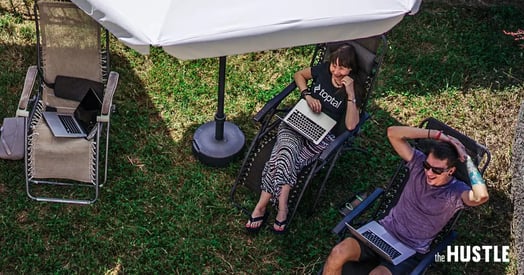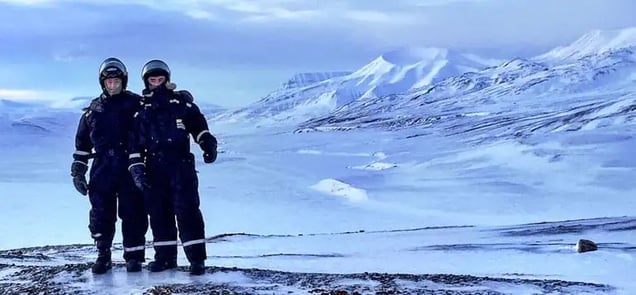The summer after I graduated high school in 2004, I was sitting in a branch office of a Morgan Stanley SVP working away at my computer building a model to calculate average exponential interest rates over time. It was simple enough: I remembered the equation from sophomore year, and it was just a matter of solving a few lines of algebra, writing a little code, and making it foolproof enough that a banker could enter the inputs on his computer while pacing around his office on a conference call with clients.

It was fun.
And there were big bonus points when I did it in only a few minutes. I shot it over to the SVP, and a minute later, he called his colleague into his office exclaiming, “You won’t believe what Breanden just did!”
It’s a nice memory.
Unfortunately, it’s not what comes to mind when I look back on my time at Morgan Stanley. As a 16-year-old overachiever, I spent the summer of my senior year wearing a suit on the top floor of a downtown corporate office doing what was then exhilarating stuff like learning about investing, coding little apps, and building client presentations.
And… staring at a clock.
I had my own little mahogany office space, and across the room there was a circular wall clock with a white face and black trim. A week into my employment, the novelty had worn off, and I found myself checking that clock more and more frequently, yearning for the end of the day. I was learning / doing cool stuff, and I always went above and beyond, but I felt trapped being there.
I was at my desk by 9 a.m. Check email. Check clock: 9:10. I soon figured out that if I got a cup of coffee, I could get rid of three minutes. Check clock: 9:13. Nice. Log back into my computer and bang out whatever work I had to do. Check clock: 9:45. I knew if I went to the bathroom, I could get rid of four minutes. Check clock: 9:49. Okay. Soon it will be lunch. Go shadow a conference call with a VP. 9:50. Check clock seven times during the call to see: 9:55, 10:10, 10:16, 10:20, 10:22, 10:23, 10:23.
Proceed to slowly go insane.
My life quickly became a mechanized routine of self-torture as I tried my hardest to pass the day so I could get the hell out and go read about investment vehicles from home or Starbucks. I hated being in an office. I hated staring at that clock. Even when I had cool stuff to do, I was 10x more efficient doing it on my own time without sitting in uncomfortable clothes in a fancy space.
Three months later, I was done and went off to university. My crash course at Morgan Stanley taught me a lot – it was a solid learning experience filled with generous and smart people – but the most important thing I learned was that I was never going to be exhilarated staring at a clock in an office.
Six years later, we started Toptal from my dorm room
In November 2010, Taso Du Val and I created Toptal. Taso and I were previously neighbors in Palo Alto, and I was now an engineer enrolled at Princeton University, paying my way through school by working as a freelance developer. Taso was a developer as well, and we were both working on startups and building our own engineering teams.
But hiring extremely good engineers was extremely difficult.
Like all founders, we needed amazing engineers on our core teams, yet the ones from our personal networks were taken by Googles, Facebooks, and sometimes by their own companies. Virtually everyone I knew (including myself) had been burned trying to outsource work to India. I wasn’t going to do that again. So the other alternative was to create a job post and then drown in resumes from unqualified people. Ugh.
Even if we did get a few good applications, it was hard to notice them through all the noise. Plus, the best engineers are often the least aggressive self-marketers. Taso and I each had the pleasure of spending two to three months interviewing and testing everyone, with a hit rate of sub 5%. The end result of this process was months wasted, risky hires made, and tens of thousands of dollars lost directly (with potentially millions of dollars lost indirectly).
So what does one do?
Taso showed me the answer. He introduced me to Ignacio Freiberg, a developer in Buenos Aires, who in a matter of weeks convinced me it was possible to build great software, and thus great companies, with a remote team. Ignacio was awesome: scary smart and impossibly proactive. We communicated non-stop. We worked non-stop. We pushed non-stop. From 5,000 miles away, he became an irreplaceable core team member almost instantly. If only there were more Ignacios!
Good news: there are more Ignacios. And we figured out how to find them.
A month after “meeting” Ignacio virtually, Taso visited me at Princeton. We sat in my two-room single on the top floor of Princeton’s Brown Hall for weeks and springboarded Toptal. Taso aptly called my room the “pressure cooker”. Sharing about 400 square feet, we set our vision, debated the intricacies of scalable intelligence testing, mapped out V1 of Toptal’s screening process, and hired our first employees. A few weeks later, Taso went back to Palo Alto, and we’ve hardly worked in the same location for more than a few days at a time since.
And yet Toptal will hit just over $80,000,000 in annual sales this year. Taso and I speak every day mostly via Skype, there are now hundreds of core team members working from more than 25 different countries, and together we support thousands of engineers working with more than 2,000 clients across 93 countries – all in real-time.
And Toptal still doesn’t have an office.
We turned down Silicon Valley
Everyone at Toptal works remotely 100% of the time, and hardly any of us live in the Bay Area. I personally have lived and worked in more than 30 countries in the last few years.
There are Toptal employees touring Europe, playing polo in Argentina, taking month-long jaunts in Asia, spending quality time in their home countries cherishing their families, and everything in between – all while working full-time at an aggressively growth-minded, VC-backed company.
We have conference calls via Skype from beaches, mountains, cities, campuses, boats, planes, etc. across the globe, and many of Toptal’s team members who speak to each other on a daily basis have never met face-to-face. Yet we are an extremely tight-knit company. I know people with Toptal tattoos.
With just a laptop, a phone, and maybe a tablet, we work together to build a real culture, a thriving community, and, of course, great software.

We could have gone to San Francisco, set up shop, raised many rounds, and pursued Toptal in the typical Valley way. But of course when Taso and I started all this, I was still in class, and everything had to happen virtually. Taso didn’t live in Princeton, and I didn’t have time to commute to NYC or SF for meetings every day.
So, using Skype as our office, we said from day one we would be distributed (meaning we would be working from anywhere but a central office), and we proceeded to “meet” people and companies all over the world using our computers. And instead of having two or three in-person meetings a day, we could do ten or twenty virtually with people who were located anywhere. We didn’t lose any time to commute, and we avoided all of the costs associated with them. No one stared at clocks, and no one wore a suit.
While working like this, we realized that we didn’t need to physically be in Silicon Valley for Toptal to take off, and this opened up a world of possibilities – literally. Taso and I are adventurous people, so we began talking about economically strategic places we could go so we could reinvest as much as possible into growing the business and skip funding rounds in the meantime. We quickly set our sights on Budapest, as one does. It was significantly cheaper than San Francisco, and, to us, significantly more fun.
As we grew in Budapest, we further embraced the freedom of not having a physical office. We traveled to dozens of nearby countries and met hundreds of incredible people – from top coders to prime ministers to CERN researchers to infamous hackers – often in the places we’d least expect. Soon our core team members were operating from Russia, Brazil, and Argentina. With our team’s coverage map widening every day, Toptal began to grow organically in that same way. We were able to practice what we preached – working remotely – and because we were entirely distributed, we figured out how to have our cake and eat it, too. We had the freedom to hire talent wherever we went and build local Toptal communities in every country we visited.

As a result, we’ve built Toptal into an elite global network, not just another freelancing site. If a company is just looking to freelance or contract out a cheap project, there are already plenty of sites for that. The world doesn’t need more fluff, and by embracing remoteness and merit over proximity and tradition, we’ve built a revenue-based, hyper-growth company with very little outside funding in just under five years. We’re creating something new, something different: a network, a culture, of empowered top talent.
You don’t need an office
By encouraging our team members to work from anywhere they want, we found that they are able to change scenery when they need to, and they end up taking fewer days off from work. We offer unlimited paid vacations, but few take them. Need to recharge? Hop on a plane to Santorini for a week or visit a friend in Montreal, all while working from the same laptop, smartphone, and tablet that you would be working from at home.
You know you’re doing it right as a company when your team has problems like this:

It works. This isn’t just numbers on a page or a study performed in a certain way to achieve desired findings. Even though we have yet to come across another 100% distributed, hyper-growth company (the famous examples of distributed teams like GitHub, Automattic, Basecamp, Stack Exchange, etc. all have leases for some kind of space), you can build big without an office.
Hire the best, no matter where they are. If you don’t, you’re going to fall behind the companies who do. It won’t be easy at first, but you will get great people, intense drive, and truly self-motivated determination across your remote team. As you get better and better at being remote, the lines between business and pleasure will blur, and things will start to take off.
Sure, many of us at Toptal have spent the past few years traveling around the globe, and our Instagrams look like we’ve been on vacation. But we’ve also been working 12-14 hours a day at the same time. No one here wants a four hour work week or the typical nine-to-five job. Our company wouldn’t work with that schedule.
When smart people are empowered — empowered to think, to execute, to travel, to be comfortable, to choose a lifestyle for themselves — they do amazing things over and over again.
Repurposed from the Huffington Post with the author’s permission

